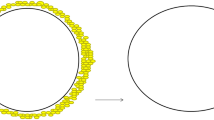Abstract
Background
One of the most popular surgical cosmetic procedures, breast augmentation, has enjoyed large acceptance in the last few decades. One of the most important factors in the dynamics established between the implants and the soft tissues after breast augmentation is the pocket plane. Surgeons have been seeking the proper plane into which the implant might be placed. The subglandular approach resulted in implant edge visibility and was thought to result in a higher incidence of fibrous capsular contractures. Despite the advantage of concealing the implant edges using the subpectoral approach, implant displacement occurred with contraction of the pectoralis muscle. The use of the retrofascial plane seems to yield the benefits of both planes without the deficits.
Methods
Since 2006, 45 patients with hypomastia have undergone subfascial breast augmentation using anatomical contour profile gel cohesive III textured implants.
Results
Pleasing long-term results have been obtained by using subfascial breast augmentation, with maintenance of a natural breast shape and a smooth transition between the soft tissue and implant in the upper pole. There were no capsular contractures and no complaints regarding displacement of the implants with contraction of the pectoralis major muscle.
Conclusions
The subfascial breast augmentation technique offers improved long-term aesthetic results because the dynamics between the implant and soft tissues have been optimized. This technique is extremely versatile and may also be used in patients requiring removal and replacement of breast implants.




Similar content being viewed by others
References
American Society for Aesthetic Plastic Surgery website. Available at http://www.surgery.org/download/2006stats.pdf
Graf RM, Bernardes A, Rippel R, Araujo LRR, Costa Damasio RC, Auersvald A (2003) Subfascial breast implant: a new procedure. Plast Reconstr Surg 111:904–908
Sampaio Goes JC, Landecker A (2003) Optimizing outcomes in breast augmentation: seven years experience with the subfascial plane. Aesth Plast Surg 27:178–184
Barbato C, Pena M, Triana C, Zambrano MA (2004) Augmentation mammoplasty using the retrofascia approach. Aesth Plast Surg 28:148–152
Jinde L, Jianliang S, Xiaoping C, Xiaoyan T, Jiaqing L, Qun M, Bo L (2006) Anatomy and clinical significance of pectoral fascia. Plast Reconstr Surg 118:1557–1560
Tebbetts JB, Adams W (2006) Five critical decisions in breast augmentation using five measurements in 5 minutes: the high five decision support process. Plast Reconstr Surg 118(Suppl):35S–45S
Adams WP Jr, Rios JL, Smith SJ (2006) Enhancing patient outcomes in aesthetic and reconstructive breast surgery using triple antibiotic breast irrigation: six-year prospective clinical study. Plast Reconstr Surg 118(Suppl):46S–52S
Savaci N, Tosun Z, Hosnuter M (2004) A simple method for breast implant placement using a drainage tube. Aesth Plast Surg 28:231–232
Author information
Authors and Affiliations
Corresponding author
Rights and permissions
About this article
Cite this article
Siclovan, H.R., Jomah, J.A. Advantages and Outcomes in Subfascial Breast Augmentation: A Two-Year Review of Experience. Aesth Plast Surg 32, 426–431 (2008). https://doi.org/10.1007/s00266-008-9141-y
Received:
Accepted:
Published:
Issue Date:
DOI: https://doi.org/10.1007/s00266-008-9141-y




